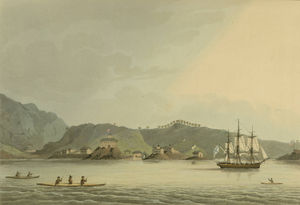Sloop-of-war: Difference between revisions
Jump to navigation
Jump to search


imported>Howard C. Berkowitz m (New page: {{subpages}}) |
imported>Robert A. Estremo m (move refs) |
||
| (2 intermediate revisions by 2 users not shown) | |||
| Line 1: | Line 1: | ||
{{subpages}} | {{subpages}} | ||
{{Image|Russian Sloop-of-War Neva.jpg|right|300px|The sloop-of-war ''Neva'' was the first Russian ship to circumnavigate the globe in 1804 under the command of [[Lieutenant Commander]] [[Yuri Lisyansky]].<ref name="Postnikov">Postnikov, A. (2002).</ref> In June, 1807 she became the first Russian ship to make contact with Australia.<ref>Massov (2006), pp. 203-214.</ref>}} | |||
A '''sloop-of-war''' is a light [[warship (sail)|sailing warship]], fitted with a single gun deck and light cannon, typically used for patrols and scouting where contact with larger warships was not expected. Typical armaments included 16-20 guns, but some had up to 28. Sloops were generally assumed to be "ship-rigged", with three masts and square sails, but small seagoing vessels with other rigging sometimes were grouped with the more standard sloops. | |||
Her commanding officer was usually a [[commander (naval)|commander]] but sometimes a [[captain (naval)|junior captain]]. In [[World War Two]], WWII [[sloop (WWII)|sloops]] were [[ocean escort]]s, with lesser capability than a [[destroyer]] or destroyer escort. | |||
==Notes== | |||
{{reflist}} | |||
Latest revision as of 16:36, 2 October 2012

(PD) Painting: Yuri Feodorovich Lisyansky
The sloop-of-war Neva was the first Russian ship to circumnavigate the globe in 1804 under the command of Lieutenant Commander Yuri Lisyansky.[1] In June, 1807 she became the first Russian ship to make contact with Australia.[2]
The sloop-of-war Neva was the first Russian ship to circumnavigate the globe in 1804 under the command of Lieutenant Commander Yuri Lisyansky.[1] In June, 1807 she became the first Russian ship to make contact with Australia.[2]
A sloop-of-war is a light sailing warship, fitted with a single gun deck and light cannon, typically used for patrols and scouting where contact with larger warships was not expected. Typical armaments included 16-20 guns, but some had up to 28. Sloops were generally assumed to be "ship-rigged", with three masts and square sails, but small seagoing vessels with other rigging sometimes were grouped with the more standard sloops.
Her commanding officer was usually a commander but sometimes a junior captain. In World War Two, WWII sloops were ocean escorts, with lesser capability than a destroyer or destroyer escort.